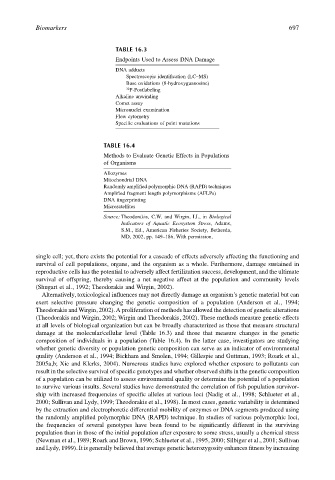Page 717 - The Toxicology of Fishes
P. 717
Biomarkers 697
TABLE 16.3
Endpoints Used to Assess DNA Damage
DNA adducts
Spectroscopic identification (LC–MS)
Base oxidations (8-hydroxyguanosine)
32 P-Postlabeling
Alkaline unwinding
Comet assay
Micronuclei examination
Flow cytometry
Specific evaluations of point mutations
TABLE 16.4
Methods to Evaluate Genetic Effects in Populations
of Organisms
Allozymes
Mitochondrial DNA
Randomly amplified polymorphic DNA (RAPD) techniques
Amplified fragment length polymorphisms (AFLPs)
DNA fingerprinting
Microsatellites
Source: Theodorakis, C.W. and Wirgin, I.I., in Biological
Indicators of Aquatic Ecosystem Stress, Adams,
S.M., Ed., American Fisheries Society, Bethesda,
MD, 2002, pp. 149–186. With permission.
single cell; yet, there exists the potential for a cascade of effects adversely affecting the functioning and
survival of cell populations, organs, and the organism as a whole. Furthermore, damage sustained in
reproductive cells has the potential to adversely affect fertilization success, development, and the ultimate
survival of offspring, thereby causing a net negative affect at the population and community levels
(Shugart et al., 1992; Theodorakis and Wirgin, 2002).
Alternatively, toxicological influences may not directly damage an organism’s genetic material but can
exert selective pressure changing the genetic composition of a population (Anderson et al., 1994;
Theodorakis and Wirgin, 2002). A proliferation of methods has allowed the detection of genetic alterations
(Theodorakis and Wirgin, 2002; Wirgin and Theodorakis, 2002). These methods measure genetic effects
at all levels of biological organization but can be broadly characterized as those that measure structural
damage at the molecular/cellular level (Table 16.3) and those that measure changes in the genetic
composition of individuals in a population (Table 16.4). In the latter case, investigators are studying
whether genetic diversity or population genetic composition can serve as an indicator of environmental
quality (Anderson et al., 1994; Bickham and Smolen, 1994; Gillespie and Guttman, 1993; Roark et al.,
2005a,b; Xie and Klerks, 2004). Numerous studies have explored whether exposure to pollutants can
result in the selective survival of specific genotypes and whether observed shifts in the genetic composition
of a population can be utilized to assess environmental quality or determine the potential of a population
to survive various insults. Several studies have demonstrated the correlation of fish population survivor-
ship with increased frequencies of specific alleles at various loci (Nadig et al., 1998; Schlueter et al.,
2000; Sullivan and Lydy, 1999; Theodorakis et al., 1998). In most cases, genetic variability is determined
by the extraction and electrophoretic differential mobility of enzymes or DNA segments produced using
the randomly amplified polymorphic DNA (RAPD) technique. In studies of various polymorphic loci,
the frequencies of several genotypes have been found to be significantly different in the surviving
population than in those of the initial population after exposure to some stress, usually a chemical stress
(Newman et al., 1989; Roark and Brown, 1996; Schlueter et al., 1995, 2000; Silbiger et al., 2001; Sullivan
and Lydy, 1999). It is generally believed that average genetic heterozygosity enhances fitness by increasing

